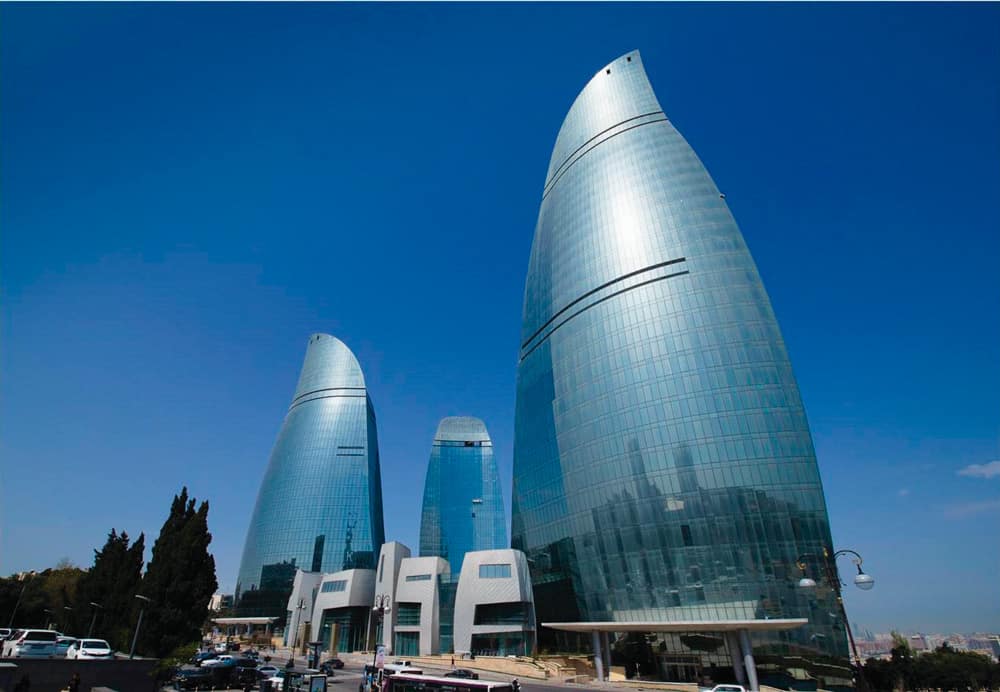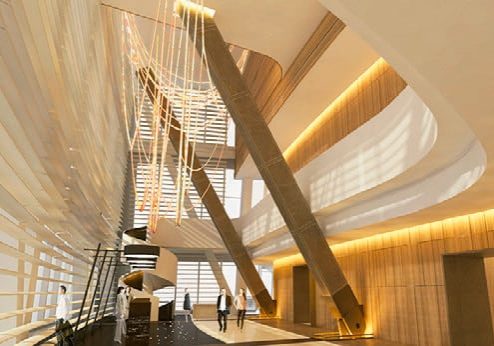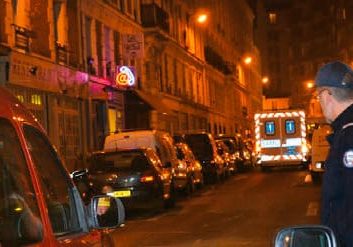ETA Melco helps light an ancient fire in Baku, Azerbaijan.
photos by Keisuke Kobayashi
Since achieving independence, Azerbaijan has been positioning its capital, Baku, as an outward-looking, high-tech city. Situated on a hill overlooking Baku Bay and the old city center, Flame Tower transformed the city’s skyline while promoting its historic identity. Baku’s history of fire worship provided the inspiration for the design, which consists of three flame-shaped towers set in a triangular shape. As some of the tallest buildings in the city, they are visible from most vantage points.
Construction had to stop several times, forcing engineers to combat frequent winds, while taking into account the seismic activity of the area.
Residential, Hotel and Office Towers
At 190 m high, the 39-story residential tower – the tallest of the three – sits to the south, accommodating 130 luxury apartments with stunning views of the Caspian Sea and Baku. The building has a gym, spa and other amenities. The 160-m-high hotel tower, operated by Fairmont Hotels, is located on the northern corner of the site, and it consists of 318 rooms, 61 of which are serviced apartments, spread over 30 floors. The neutral palette used in the decoration of the rooms is accentuated by bursts of color, culminating with the Royal Suite with a deep, rich burgundy finish. Custom features, like the 6-m-tall crystal teardrop chandelier attract attention in the 17-m-tall lobby. A collection of contemporary art, commissioned from Farmboy Fine Arts, complements the building’s innovative design.
The 140-m-tall office tower, located on the west side of the complex, provides more than 33,000 m2 of flexible class-commercial office space. The 78-m-high retail podium serves as the anchor for the project, providing leisure and retail facilities such as restaurants, cafes, cinemas and shops for the three towers’ residents and visitors. It has a wavy glass ceiling decorated with a honeycomb pattern. Each tower offers 50 parking spaces.
Façades
The façades of the three towers are turned into gigantic display screens with the use of more than 10,000 high-power LED luminaires, supplied by the Osram subsidiary Traxon Technologies and Vetas Electric Lighting. They are fully glazed and use a mixture of tinted orange and blue. The orange gives them the appearance of fire in accordance with its name and form. Façades also boast a grid pattern that accentuates the shape of the towers. All this creates the effect of giant flames flaring, emphasizing the main idea of the towers’ title. During nighttime, exterior LEDs depict the flames, an unfurled flag of Azerbaijan and other images that move impressively.
Building Structure
The main structural systems of the three towers are of reinforced concrete. By contrast, the upper floors are built with steel-frame filigree, creating a spacious place for special use.
Three joints, constructed with steel pipe 610 mm in diameter, make up the primary framework of the needles. Following the geometry of the design, welded connection points are used for biaxial curved sections of the tubes. The sides are joined to the frame by bending the strength connections to reduce the deformation of the construction, which is 30 m in height. A special triangular cross-section, typically made of sheetmetal and round steel bars, is used for these columns, allowing for as wide a view of the outside as possible. This section was modeled with the SHAPE-THIN Dlubal program, then imported to RFEM.
Its continuous curved design made these structures a true challenge, which is rarely attempted. They were designed by HOK Architects and promoted by Azinko MMC in Caucasia. Construction had to stop several times, forcing engineers to combat frequent winds, while taking into account the seismic activity of the area. Wind loads governing the design were determined by a wind report, which reached up to 7 knots/m². So, it took additional diagonal curved-steel construction on the rear side to reduce the total strain on the needles at the required 90 mm.
Elevators
Flame Tower has 45 Mitsubishi Electric elevators and 10 Mitsubishi Electric escalators. Thirty-one of those are passenger elevators, three are firefighters’ elevators, and 11 are service elevators. Twenty-one elevators are driven by Mitsubishi Electric’s popular range of heavy-duty permanent-magnetic gearless (PML) machines. One of the five-mT PML machines posed a real challenge for engineers when they hoisted it to the machine room at the top of the tower. The speed of the elevators varies from 60-240 mpm. The capacity of the elevators ranges from 1050-2500 kg (14-33 passengers).
Hotel passenger elevators one through six have an AI 2200 C car-group controller, and run at 240 mpm with a capacity of 1600 kg. Two elevators serve the 29th floor, two serve the 28th and two serve the 27th floor. In order to reach any floor without changeover, all floors are equipped with Mitsubishi Electric’s destination-oriented allocation system (DOAS). It controls an elevator group in accordance with the floors registered at the hall. Mitsubishi Electric expanded the application of the hall operating panels, which comply with EN 81-70, to a maximum of 64 floors. DOAS is provided for 16 elevators in this project, servicing all floors due to the shape of the building.
The cabins have two car-operating- panel LCD screens in the front return panel and two 15-in. LCD screens at the car transom panel displaying a live feed transmitted from a dedicated server. Each floor has four LCD displays incorporated with a dial pad.
Adding to the beauty of the lobby, hotel passenger elevators seven through nine are panoramic units serving the spa and conference centers. The hotel also includes three service elevators, one firefighters’ elevator and five other shuttle elevators, bringing the total number of units in the hotel to 18.
Office passenger elevators one through five and a freight elevator serve as a six-car group with DOAS on all floors. The freight elevator has two doors and two gates. The capacity of each elevator is 2000 kg, running at 240 mpm. The cabin doors have widths of 1,100 mm in the front and 1,300 mm in the rear. The net weight of the motor is 5 mT.
Residential passenger elevators one through four, the freight elevator, personnel lift number five and passenger elevator six are shuttle elevators.
Construction was completed by the deadlines. Flame Tower, which has become a symbol of modern Baku, received the MIPIM 2013 International Award for best hotel and resort. Other influential forums’ urban surveys position HOK’s lighting designed for the towers as one of the newest and most accomplished. As final confirmation of Flame Tower’s contribution to the city, Lamborghini opened its branch in Azerbaijan on the ground floor of the east tower of the development.

The façades of the three towers are turned into gigantic display screens with the use of more than 10,000 high-power LED luminaires. 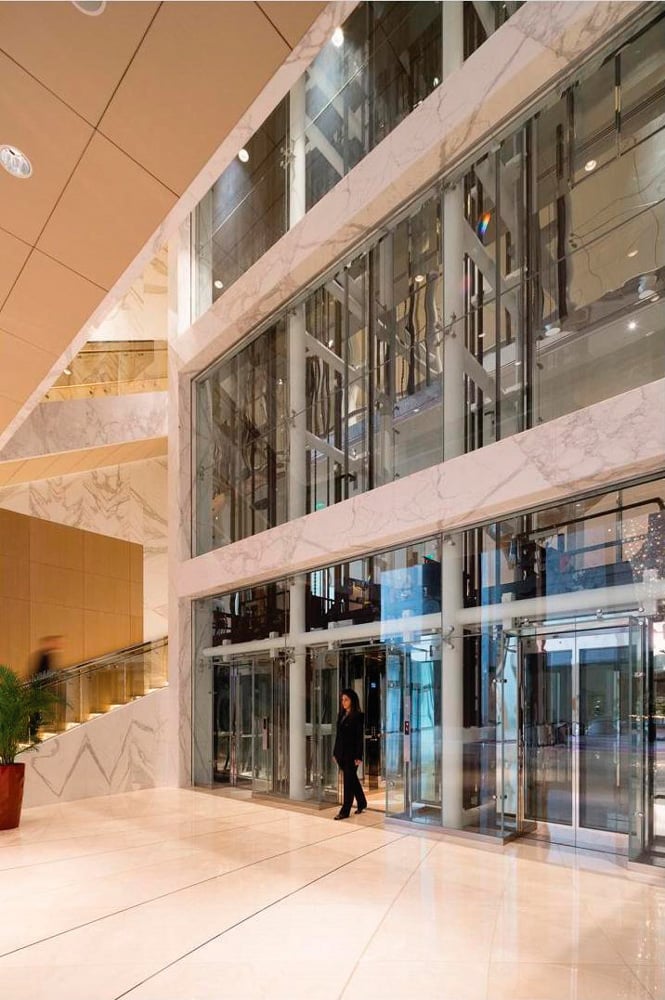
Hotel passenger elevators seven through nine are panoramic units serving the spa and conference centers. 
The cabins have two LCD screens in the front return panel and two at the car transom panel. 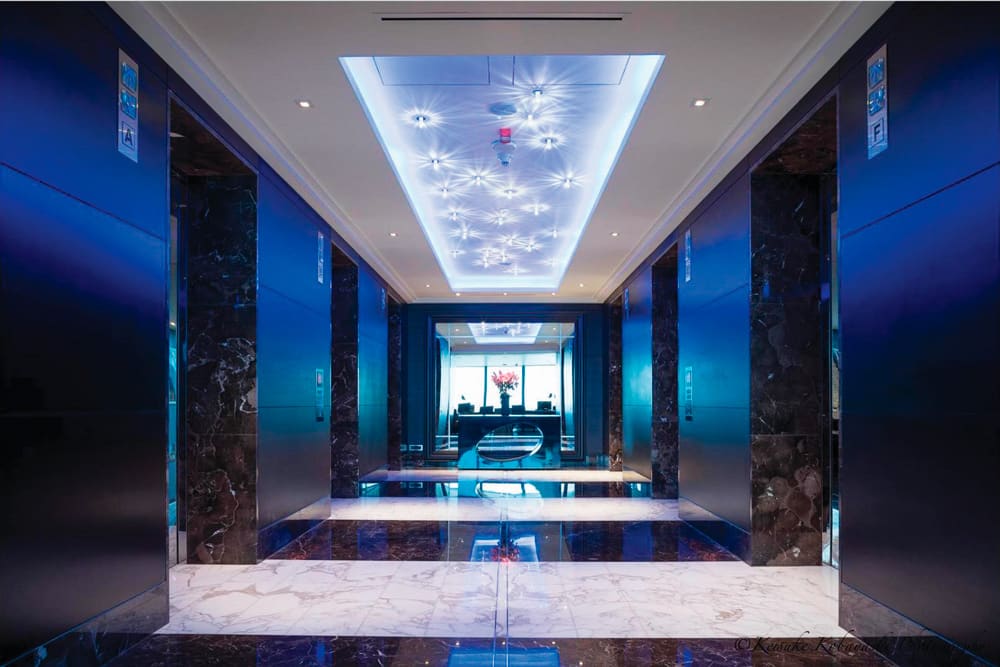
Flame Tower has 45 Mitsubishi Electric elevators and 10 Mitsubishi Electric escalators.
Get more of Elevator World. Sign up for our free e-newsletter.
